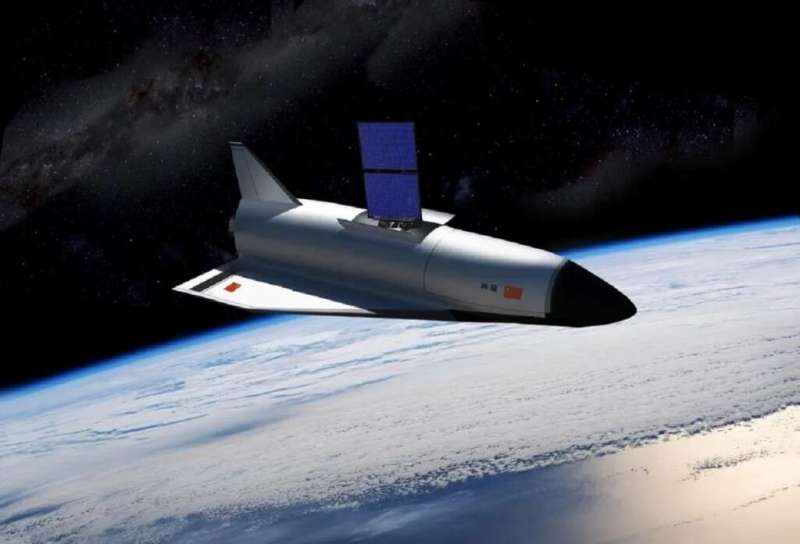A lot has changed since the last Space Age. Unlike the days of Sputnik, Vostok, Mercury, and Apollo, the current era is not defined by two superpowers constantly vying for dominance and one-upmanship. More than ever, international cooperation is the name of the game, with space agencies coming together to advance common exploration and science goals.
Similarly, there is the way the private space sector has become a major participant, providing everything from launch services and commercial payloads to satellite constellations and crews.
But in some ways, old habits die hard. Since the turn of the century, China has emerged as a major power in space, to the point of becoming a direct competitor with NASA's human space programs. For the past few years, China has been developing a reusable autonomous spaceplane to compete with the X-37B Orbital Test Vehicle (OTV).
Known as Shenlong ("divine dragon"), this spaceplane recently concluded its second test flight after spending 276 days in orbit. Though the details are scant, the Chinese state media company Xinua declared the flight a breakthrough for the Chinese space program.
The Chinese reusable experimental spaceplane, the Chongfu Shiyong Shiyan Hangtian Qi (CSSHQ), has remained steeped in mystery since it first came to light. During its previous test flight (CSSHQ 1), the spaceplane took off on September 4, 2020, and spent a brief two days in orbit. For its second flight (CSSHQ-2), the Chinese spaceplane took off from the Jiuquan Satellite Launch Center in the Gobi Desert on August 4, 2022, atop a Long March-2F/T rocket (CZ-2) and reportedly landed at Juiquan again on Monday, May 8.
The Chinese state news agency Xinhua issued a statement shortly after the spaceplane landed (reportedly in Jiuquan). The spaceplane's manufacturer, the China Aerospace Science and Technology Corp. (CASC), reshared the Xinhua statement via the Chinese social media platform Weixin:
"The reusable test spacecraft successfully launched by our country at the Jiuquan Satellite Launch Center successfully returned to the scheduled landing site on May 8 after flying in orbit for 276 days. The complete success of this test marks an important breakthrough in my country's research on reusable spacecraft technology, which will provide a more convenient and inexpensive way to and from the peaceful use of space in the future."
No details were given about the mission, the spacecraft, or what operations were conducted in orbit. However, SpaceNews correspondent Andrew Jones recapped the CCSHQ's activities throughout the test flight and recapped them in a recent article.
"The spacecraft performed numerous small and much larger orbital maneuvers during its flight, with adjustments in recent weeks made in preparation for landing," he wrote. "The landing is likely to have taken place at the Lop Nur military base in Xinjiang. Information on the spacecraft's orbit suggests an orbital track over the facility around 0020 UTC provided the opportunity for landing."
As Jones wrote back in August 2022, the spacecraft also released a small satellite into orbit 90 days into its flight. While the purpose and nature of this satellite are unknown, tracking data obtained by the U.S. Space Force (USSF) revealed that the small satellite remained in very close proximity to the spaceplane. While this flight was a big step for China's research into reusable spacecraft technology, it pales in comparison to the accomplishments of the X-37B, which has executed six test flights since April 2010.
During its last flight (OTV-6), the OTV spent over nine-hundred days in space and even deployed a series of science experiments while in orbit. Like the CCSHQ's activities, the details about the OTV's flights have remained highly classified. However, various sources have confirmed that the objectives include developing orbital reconnaissance vehicles for military use and testing reusable spacecraft technologies, hypersonic engines, and autonomous guidance systems.
Concerning reusability, China is developing spacecraft as part of a larger program, including a super-heavy launch system similar to SpaceX's Starship.
The concept was presented by the China Academy of Launch Vehicle Technology (CALT) in April 2021 during the sixth annual Aerospace Industry Achievement Exhibition (aka. "National Space Day") in Nanjing.
The China Aerospace Science and Industry Corporation (CASIC) is also pursuing its own reusable spaceplane, known as the Tengyun ("cloud rider"). According to a video released by CASIC during the 2021 Zhuhai Air Show (shown above), this vehicle would be part of a two-stage launch system that relies on an air-launch vehicle (similar to Virgin Galactic).
This latest development showcases the progress China has made in recent years. In terms of space station technology, robotic exploration on the Moon (the Chang'e program) and Mars (the Tianwen-1 orbiter and Zhurong rover), and crewed spaceflight, China has emerged as a global powerhouse.
Later this decade, China plans to send the first taikonauts to the Moon and establish the International Lunar Research Station (ILRS), in direct competition with NASA's Artemis Program. In 2033, they hope to send the first crewed missions to Mars, precisely when NASA is hoping to do the same.
- alf9872000 and Mutton
-

 2
2



Recommended Comments
There are no comments to display.
Join the conversation
You can post now and register later. If you have an account, sign in now to post with your account.
Note: Your post will require moderator approval before it will be visible.